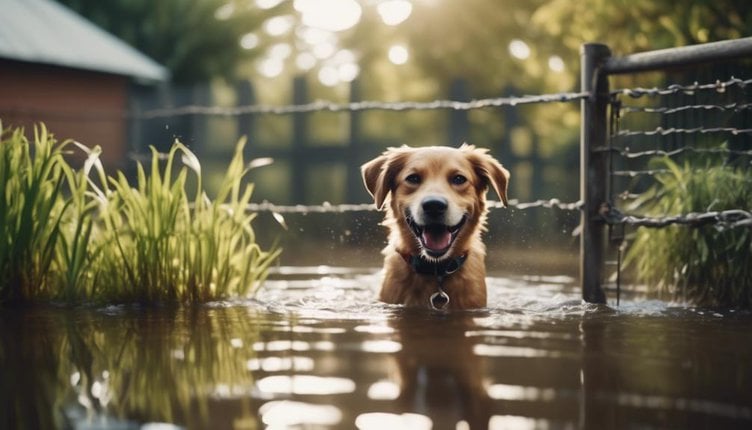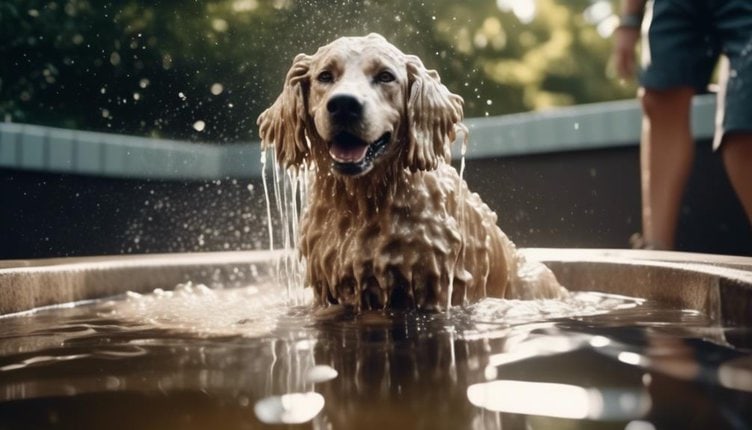Hey there, dog lovers! You won't believe the risks your furry friends face when it comes to Leptospirosis.
This nasty bacterial infection caused by the Leptospira bacteria is a real danger to dogs worldwide.
Imagine your adventurous pup exploring the great outdoors, running freely in the countryside. Sounds innocent, right? Well, think again. Because lurking out there is the potential danger of Leptospirosis.
But fear not! I'm here to give you the lowdown on this serious threat and, more importantly, how to prevent it.
Let's dive into this crucial topic and make sure our precious pooches stay safe and sound.
Understanding Leptospirosis in Dogs
Leptospirosis is a bacterial infection that commonly affects dogs. Understanding its causes, symptoms, and transmission is crucial for the prevention and management of this potentially life-threatening disease.
To diagnose leptospirosis in dogs, veterinarians typically rely on a combination of clinical signs, laboratory tests, and serology. The clinical signs of leptospirosis can vary widely and may include fever, lethargy, vomiting, diarrhea, and jaundice. Laboratory tests, such as blood and urine analysis, can help identify the presence of the Leptospira bacteria or its antibodies. Serology, which involves testing blood samples for specific antibodies, can determine if a dog has been exposed to the bacteria in the past.
Once a diagnosis is confirmed, prompt treatment is essential to prevent further complications. Treatment for leptospirosis in dogs usually involves a combination of antibiotics, such as doxycycline or amoxicillin, and supportive care. Antibiotics help eliminate the bacteria from the dog's system, while supportive care, such as intravenous fluids and medications to manage symptoms, helps the dog recover and manage any complications.
It's important to note that early detection and treatment are crucial for a successful outcome in dogs with leptospirosis. Therefore, if a dog shows any signs of illness or has potential exposure to the bacteria, it's important to seek veterinary care promptly.
Common Symptoms of Leptospirosis
Common symptoms of leptospirosis in dogs can vary widely and may include fever, lethargy, vomiting, diarrhea, and jaundice. These symptoms aren't exclusive to leptospirosis and can be indicative of other illnesses as well. Therefore, it's crucial to consult a veterinarian for a proper diagnosis.
Fever is one of the most common symptoms of leptospirosis in dogs. It typically presents as a high body temperature, often accompanied by lethargy. Dogs may appear weak and lack energy, exhibiting a decreased interest in their usual activities. Vomiting and diarrhea are also common symptoms, as the bacteria affect the gastrointestinal tract. These symptoms can lead to dehydration if left untreated.
Another symptom of leptospirosis in dogs is jaundice, which is characterized by a yellowing of the skin, eyes, and gums. This occurs due to liver damage caused by the bacteria. If left untreated, leptospirosis can progress and cause severe complications such as kidney failure, respiratory distress, and even death.
Prompt treatment is essential to effectively manage leptospirosis in dogs. Treatment options often include antibiotics to eliminate the bacteria from the dog's system. Additionally, supportive care such as intravenous fluids may be necessary to address dehydration and maintain hydration levels. In severe cases, hospitalization may be required to closely monitor the dog's condition and provide intensive care.
How Leptospirosis Is Transmitted to Dogs

After understanding the common symptoms of leptospirosis in dogs, it's crucial to explore how this disease is transmitted to our canine companions. Leptospirosis is primarily transmitted through the urine of infected animals, which can contaminate the environment and serve as a source of infection for other animals. Here are the key transmission routes for leptospirosis in dogs:
- Direct contact with infected urine: Dogs can become infected by coming into contact with the urine of infected animals, such as rats, mice, raccoons, and other wildlife. This can occur through sniffing or licking contaminated surfaces or water sources.
- Indirect contact: Dogs can also become infected by indirect contact with contaminated environments, such as soil, water, or objects that have been contaminated with the urine of infected animals. This can happen when dogs walk on contaminated ground or swim in contaminated water.
- Ingestion of infected tissues or water: Dogs may become infected if they consume tissues from infected animals or drink water that has been contaminated with the urine of infected animals.
- Transmission from mother to puppies: Leptospirosis can also be transmitted from an infected mother dog to her puppies during birth or through nursing.
Understanding the transmission routes of leptospirosis is essential in implementing effective prevention measures. By avoiding contact with contaminated environments and ensuring proper vaccination, dog owners can significantly reduce the risk of their pets contracting this disease and ensure their well-being.
Importance of Vaccination for Leptospirosis
Vaccination plays a crucial role in preventing leptospirosis in dogs. The vaccine has been shown to be effective in reducing the severity of the disease and preventing its transmission.
It's recommended that dogs receive the leptospirosis vaccine as part of their routine vaccination schedule, especially if they live in areas where the disease is prevalent or have a high risk of exposure.
Vaccine Effectiveness
Leptospirosis vaccination is a crucial preventive measure for dogs, effectively reducing the risk of infection and its associated complications. Here are some key points regarding the effectiveness of the vaccine:
- Vaccine efficacy: The leptospirosis vaccine is highly effective in preventing infection caused by the Leptospira bacteria. It stimulates the dog's immune system to produce antibodies that can fight against the bacteria, reducing the chances of infection.
- Duration of protection: The vaccine provides immunity for a certain period of time, typically around one year. Regular booster shots are necessary to maintain protection against leptospirosis.
- Vaccine side effects: Some dogs may experience mild side effects such as pain or swelling at the injection site, mild fever, or lethargy. These side effects are usually temporary and resolve on their own.
- Importance of vaccination: Vaccinating dogs against leptospirosis not only protects the individual dog but also helps in preventing the spread of the disease to other animals and humans. It's an important step in ensuring the overall health and well-being of dogs and the community.
Recommended Vaccination Schedule
Are you aware of the recommended vaccination schedule for protecting dogs against leptospirosis?
Vaccination is crucial in preventing this potentially deadly disease in dogs. The recommended vaccination schedule for leptospirosis consists of an initial vaccination, followed by booster shots.
The initial vaccination is usually given to puppies at around 12-16 weeks of age. Booster shots are then administered annually or as recommended by your veterinarian.
It's important to follow this schedule to ensure your dog's protection against leptospirosis. Vaccines have been proven to be effective in preventing the disease and reducing its severity if your dog does become infected.
The effectiveness of the vaccine is attributed to its ability to stimulate the dog's immune system to produce antibodies against the Leptospira bacteria.
Preventive Measures for Leptospirosis

To prevent leptospirosis in dogs, vaccination is crucial. Vaccines are available that provide protection against the most common strains of the leptospira bacteria.
In addition to vaccination, maintaining good environmental hygiene practices can help minimize the risk of infection. This includes proper waste disposal and regular cleaning of areas frequented by dogs.
It's also important to prevent dogs from accessing or drinking contaminated water sources, as this is a common route of transmission for the bacteria.
Vaccination for Prevention
Vaccination is an essential preventive measure against leptospirosis in dogs, providing crucial protection against this potentially life-threatening bacterial infection. Here are some important points to consider regarding vaccination for leptospirosis:
- Vaccine side effects: Like any medical intervention, vaccines can have potential side effects. Common side effects of the leptospirosis vaccine in dogs include mild lethargy, soreness at the injection site, and transient fever. Severe allergic reactions are rare but possible. It's important to discuss any concerns about vaccine side effects with your veterinarian.
- Alternative prevention methods: While vaccination is the most effective way to prevent leptospirosis, there are some alternative prevention methods. These include minimizing exposure to contaminated water sources, keeping your dog away from wildlife, and practicing good hygiene, such as wearing gloves when handling potentially infected animals or their urine.
- Vaccine schedule: Puppies should receive their first leptospirosis vaccine between 12 and 16 weeks of age, followed by a booster shot 2 to 4 weeks later. Adult dogs should receive an initial vaccination, followed by annual or triennial booster shots, depending on the vaccine used and the dog's risk of exposure.
- Consult your veterinarian: Each dog's vaccination needs may vary based on their lifestyle, location, and individual risk factors. It's important to consult with your veterinarian to determine the best vaccination schedule and options for your dog's specific needs.
Environmental Hygiene Practices
After discussing the importance of vaccination for preventing leptospirosis in dogs, it's crucial to address the significance of environmental hygiene practices as additional preventive measures against this bacterial infection.
Environmental cleanup plays a vital role in reducing the transmission of leptospirosis. The bacteria responsible for this disease can survive in moist environments, such as soil and standing water, for prolonged periods. Therefore, it's essential to regularly clean and disinfect areas where dogs may come into contact with contaminated surfaces.
This includes removing any urine or fecal matter promptly and thoroughly disinfecting the area. Additionally, it's important to prevent access to stagnant water sources, as these can serve as breeding grounds for the bacteria.
Avoidance of Contaminated Water
Implementing preventive measures to avoid contaminated water is crucial in reducing the risk of leptospirosis transmission in dogs. Here are some ways to ensure the safety of water sources:
- Boiling: Boiling water helps kill any potential leptospirosis bacteria present in the water. It's a simple and effective purification method.
- Chlorination: Adding chlorine tablets or bleach to water can eliminate the bacteria, making it safe for consumption. However, it's important to follow the recommended dosage.
- Filtration: Using water filters, such as activated carbon filters, can remove harmful bacteria and ensure clean water for your dog.
- Avoiding stagnant water: Discourage your dog from drinking water from stagnant sources like puddles or ponds. These are common breeding grounds for leptospirosis bacteria.
Hygiene Practices to Minimize Leptospirosis Risk

To minimize the risk of leptospirosis in dogs, practicing proper hygiene is essential. Implementing personal protective measures and maintaining a thorough cleaning routine are crucial steps in reducing the transmission of this bacterial infection. When handling potentially infected animals or their urine, it's important to wear gloves and other protective gear to prevent direct contact. Additionally, washing hands thoroughly with soap and water after handling dogs or contaminated objects is crucial to eliminate any potential pathogens.
In terms of cleaning routine, it's recommended to regularly disinfect areas where dogs may have urinated or defecated, especially if they've access to the outdoors. Leptospira bacteria can survive in moist environments for long periods, so using a disinfectant that's effective against this pathogen is important. Additionally, it's advisable to clean and disinfect any dog bedding, toys, and bowls regularly to prevent the accumulation of bacteria.
It is important to note that while personal protective measures and cleaning routines are crucial in minimizing the risk of leptospirosis, they shouldn't replace vaccination. Vaccinating dogs against leptospirosis is the most effective preventive measure. Therefore, in addition to practicing good hygiene, dog owners should consult their veterinarians to ensure their pets are up to date on their vaccinations.
Seeking Veterinary Care for Leptospirosis
When a dog is suspected of having leptospirosis, seeking veterinary care promptly is crucial to ensure proper diagnosis and treatment. Leptospirosis is a serious bacterial infection that can have severe consequences if left untreated.
Here are four important steps to take when seeking veterinary treatment for leptospirosis:
- Contact a veterinarian: As soon as you suspect your dog may have leptospirosis, contact a veterinarian and explain the symptoms you have observed. They'll be able to guide you on the next steps and may recommend bringing your dog in for an examination.
- Diagnostic tests: To confirm a diagnosis of leptospirosis, your veterinarian may perform various tests, such as blood tests or urine tests. These tests can help identify the presence of the bacteria and determine the appropriate treatment.
- Treatment options: Once diagnosed, your veterinarian will discuss the treatment options available for your dog. This may include medications such as antibiotics to eliminate the bacteria and supportive care to manage symptoms and prevent complications.
- Follow-up care: After initial treatment, it's important to follow your veterinarian's instructions for follow-up care. This may include additional tests to monitor your dog's progress and ensure that the infection has been successfully treated.
Seeking veterinary care promptly and following through with the recommended treatment plan is essential for the successful management of leptospirosis in dogs. By working closely with your veterinarian, you can help ensure the best possible outcome for your furry friend.
Frequently Asked Questions
Can Humans Contract Leptospirosis From Dogs?
Humans can contract leptospirosis from dogs, as it is a zoonotic disease. The bacteria causing leptospirosis can be transmitted through contact with infected urine or contaminated water. Proper hygiene and vaccination can help prevent transmission.
Are All Dogs at Risk of Contracting Leptospirosis?
Not all dogs are equally susceptible to contracting leptospirosis. Factors such as geographical distribution, exposure to contaminated water sources, and vaccination status play a role in determining a dog's risk of contracting the disease.
Can Leptospirosis Be Transmitted Through Dog Urine?
Yes, leptospirosis can be transmitted through dog urine. It is one of the main transmission routes of the disease. Prevention measures include vaccinating dogs, avoiding contact with infected urine, and practicing good hygiene.
How Effective Is the Leptospirosis Vaccine for Dogs?
The leptospirosis vaccine for dogs is highly effective in preventing the disease. Studies have shown that it provides a strong immune response and protects against various strains of the bacteria. Side effects are generally mild and rare.
What Are the Potential Long-Term Effects of Leptospirosis in Dogs?
Long-term consequences of leptospirosis in dogs can include organ damage. The disease can affect the liver, kidneys, and other vital organs, leading to potential complications and health issues for the dog.





